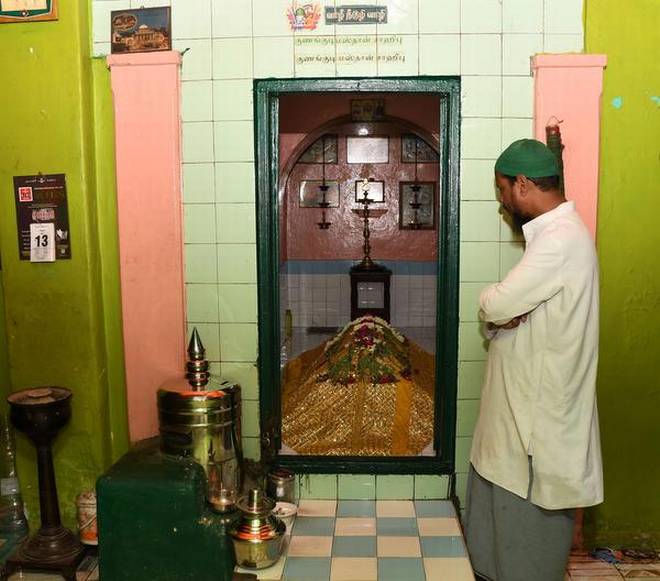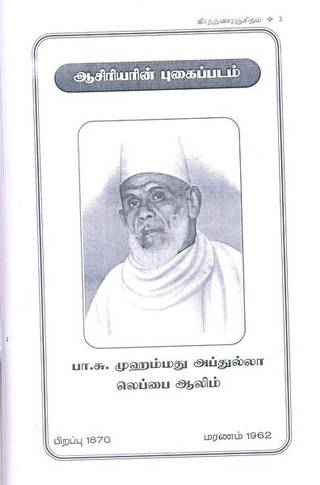TAMIL NADU :

Written with a knowledge of grammar and aesthetics, their songs are immortal
If you think of the Muslim link to Carnatic classical music, Sheikh Chinna Moula and his descendants and disciples are the first that come to mind. In the 1970s, T.M. Abdul Azeez was a violin accompanist on the Carnatic platform. He is now settled in Kerala, where he teaches music. Abraham Pandithar’s Karunamirtha Sagaram (1917) lists a few Mohammedan names as performing artistes though it is difficult to fathom now if they were performing in the Hindustani or Carnatic styles.
Gulab Mantil is one — he claimed to be a descendant of Mian Tansen of Akbar’s Court and was under the patronage of the Sivaganga rulers. He was adept at various instruments. On Chottu Mian there is no information other than the fact that he was a good singer of Hindustani Music. Nannu Mian and Mirali are listed as brothers, who were noted for their skill on the dholak. Closer home, at Tondiarpet we have the dargah of Kunangudi Mastan Sahib who is propitiated with music of the Sufi variety.
Given this background, it was a revelation when PAK Mohammad Sulaiman walked in with PS Ilyas of Kayalpattinam into the Music Academy a month or so ago. The latter had with him a precious possession — a fragile copy of a book published in 1909. Titled Kirtanaranjitham, it was a compilation of songs composed by his grandfather and Mohammad Sulaiman’s great grandfather, PS Muhammad Abdullah Labbai. It was printed at the Kalarathnakara Press, Madras.
Famous jeweller
A preface to the book gives details of the composer’s antecedents. His grandfather, Sheikh Sadakatullah was a Kazi (judge) at Kayalpattinam and had the privilege of moving about in a palanquin. That made him Pallakku Labbai to the locals. His son, Muhammad Suleiman Labbai got into the precious stone trade and his three sons, of whom the composer was the second, followed him into the business. The first and third sons set up offices in Colombo while Muhammad Abdullah Labbai (1870-1962), the composer, moved to Bombay. He made such a name for himself in the business that jewellers referred to him as Abdullah Jauhari. But his attachment to the dargah where the family prayed, the Shahibu Appa Thaikka at Kayalpattinam, was such that he eventually moved back to take care of it. He is also buried there.

Muhammad Abdullah Labbai has composed around 90 songs as per this book. It is also stated in the preface that the composer presented all of these at the dargah. What is interesting is that some of the songs are still being sung there, though the tunes have changed over time. The book sadly lacks notation (it must be remembered that notation in print was not common practice in the early 1900s). But ragas and talas are provided for every song. The popular ragas are all there, with preponderance for usage of Khamas, Mohanam and Kalyani. There are certain ragas that are not easy to identify. Names such as Desikam, Karnataka Desikam, Mohana Thodi and Nilakambodi are puzzling.
The composer was clearly well aware of the laws of composition and follows the requisites of prosody and alliteration. The language used is Manipravalam — a mix of Sanskrit, Tamil and Urdu/Persian. The bulk of the songs are in the usual kriti structure of pallavi, anupallavi and charanam. The last named are usually three and in some songs, four in number. The mudra of Abdullah appears in all the pieces.
Perusing the songs, you see all the familiar themes of Tamizh Padams — the lovelorn maiden yearning for union with the Supreme, the sending of messages to the divine via swans and companions, berating the Beloved for His heartlessness, and songs of surrender. Besides these, there are songs in the Thevaram format and some structured as Kannis. Certain songs are on specific locations where holy personages are buried, in the manner of kshetra kritis. These include Kayalpattinam, Manjakollai, Kizhakkarai, Saragam/Ervadi in Thirunelveli District, Cannanore in Kerala and Kandy in Sri Lanka.
The book follows the format for music publications of its time. There are benedictory verses in form of kappu, kanni and viruttam. Besides, like the ratha bandams that Tamil scholars of yore indulged in when patterns like chariots could emerge from the way they wrote verses, Muhammad Abdullah Labbai has worked on calligraphy by way of a Chithirakkavi Kattalai Kalithurai. His scholarship came in for praise from several Muslim men of letters, all of whom wrote verses in his praise, which were included in the first edition.
The 1909 publication was reprinted in 1963. This was done with the support of the family business in Colombo. Hussain Bhagavatar of the Panchalingapuram Jam’ath kept the songs in circulation for much of the 20th century. The descendants of the composer are now in the process of bringing out a new edition.
source: http://www.thehindu.com / The Hindu / Home> Society> Faith / by V. Sriram / June 14th, 2018








